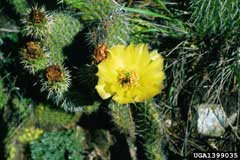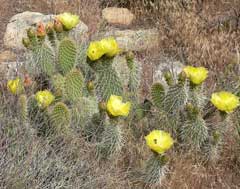 |
|
http://www.invasive.org/ |
 |
| http://commons.wikimedia.org/wiki/User:Stan_Shebs |
Translate this page:
Summary
Physical Characteristics

 Opuntia polyacantha is an evergreen Perennial growing to 0.2 m (0ft 8in) by 1 m (3ft 3in).
Opuntia polyacantha is an evergreen Perennial growing to 0.2 m (0ft 8in) by 1 m (3ft 3in).
See above for USDA hardiness. It is hardy to UK zone 3 and is not frost tender. It is in leaf all year. The species is hermaphrodite (has both male and female organs) and is pollinated by Insects.
Suitable for: light (sandy) and medium (loamy) soils and prefers well-drained soil. Suitable pH: mildly acid, neutral and basic (mildly alkaline) soils. It cannot grow in the shade. It prefers dry soil and can tolerate drought.
UK Hardiness Map
US Hardiness Map
Synonyms
Plant Habitats
Cultivated Beds; East Wall. By. South Wall. By.
Edible Uses
Edible Parts: Fruit Seed Stem
Edible Uses: Gum
Fruit - raw or dried for later use[216, 257]. The dried fruit can be mixed into stews or used to thicken soups[183]. The fruit is dry and spiny[200]. It is up to 3cm long[235]. Young pads are boiled and fried[183, 257]. The large hairs are burnt off, the pads are boiled and the remaining thorns washed off. The pads are then dipped in a syrup made from boiling sweetcorn seeds and then eaten[216]. Seed - dried, parched and ground into a meal, then added to flour and used in making cakes etc[183].
References More on Edible Uses
Medicinal Uses
Plants For A Future can not take any responsibility for any adverse effects from the use of plants. Always seek advice from a professional before using a plant medicinally.
Astringent Diuretic
The stems are astringent and diuretic[257]. An infusion is used in the treatment of diarrhoea[257]. A poultice of the flesh has been used to treat skin sores, infections, wounds and back aches[257].
References More on Medicinal Uses
The Bookshop: Edible Plant Books
Our Latest books on Perennial Plants For Food Forests and Permaculture Gardens in paperback or digital formats.

Edible Tropical Plants
Food Forest Plants for Hotter Conditions: 250+ Plants For Tropical Food Forests & Permaculture Gardens.
More

Edible Temperate Plants
Plants for Your Food Forest: 500 Plants for Temperate Food Forests & Permaculture Gardens.
More

More Books
PFAF have eight books available in paperback and digital formats. Browse the shop for more information.
Shop Now
Other Uses
Dye Gum Mordant
The peeled stems have been used as a mordant in fixing dyes[257]. A pink to red dye is obtained from the fruit[257]. A gum is obtained from the stem that can be used as an adhesive[257].
Special Uses
References More on Other Uses
Cultivation details
Requires a sandy or very well-drained soil[160]. Prefers a pH in the range 6 to 7.5[200]. Must be kept fairly dry in winter but likes a reasonable supply of water in the growing season[200]. A position at the base of a south-facing wall or somewhere that can be protected from winter rain is best for this plant. Requires warmth and plenty of sun. Plants tolerate considerable neglect. This species is very cold tolerant and can succeed outdoors in a selected site in many areas of the country[200].
References Carbon Farming Information and Carbon Sequestration Information
Temperature Converter
Type a value in the Celsius field to convert the value to Fahrenheit:
Fahrenheit:
The PFAF Bookshop
Plants For A Future have a number of books available in paperback and digital form. Book titles include Edible Plants, Edible Perennials, Edible Trees,Edible Shrubs, Woodland Gardening, and Temperate Food Forest Plants. Our new book is Food Forest Plants For Hotter Conditions (Tropical and Sub-Tropical).
Shop Now
Plant Propagation
Seed - sow early spring in a very well-drained compost in a greenhouse. When they are large enough to handle, prick the seedlings out into individual pots and grow them on in the greenhouse for at least their first two winters. Plant them out into their permanent positions in late spring or early summer, after the last expected frosts. Give the plants some protection from winter wet. Make sure you have some reserve plants in case those outdoors do not overwinter. Cuttings of leaf pads at any time in the growing season. Remove a pad from the plant and then leave it in a dry sunny place for a couple of days to ensure that the base is thoroughly dry and has begun to callous. Pot up into a sandy compost. Very easy, rooting quickly.
Other Names
If available other names are mentioned here
Native Range
NORTHERN AMERICA: Canada (Saskatchewan (south), Alberta (south), British Columbia (south)), United States (Kansas (w. & n.e.), Nebraska (west), North Dakota, South Dakota, Oklahoma (Cimarron Co.), Colorado, Idaho, Montana, Wyoming, New Mexico, Texas (west), Arizona, California, Nevada, Utah), Mexico (Chihuahua (north))
Weed Potential
Right plant wrong place. We are currently updating this section.
Please note that a plant may be invasive in one area but may not in your area so it's worth checking.
Conservation Status
IUCN Red List of Threatened Plants Status :

Growth: S = slow M = medium F = fast. Soil: L = light (sandy) M = medium H = heavy (clay). pH: A = acid N = neutral B = basic (alkaline). Shade: F = full shade S = semi-shade N = no shade. Moisture: D = dry M = Moist We = wet Wa = water.
Now available:
Food Forest Plants for Mediterranean Conditions
350+ Perennial Plants For Mediterranean and Drier Food Forests and Permaculture Gardens.
[Paperback and eBook]
This is the third in Plants For A Future's series of plant guides for food forests tailored to
specific climate zones. Following volumes on temperate and tropical ecosystems, this book focuses
on species suited to Mediterranean conditions—regions with hot, dry summers and cool, wet winters,
often facing the added challenge of climate change.
Read More
Expert comment
Author
Haw.
Botanical References
200204
Links / References
For a list of references used on this page please go here
Readers comment
| Add a comment |
|
If you have important information about this plant that may help other users please add a comment or link below. Only comments or links that are felt to be directly relevant to a plant will be included. If you think a comment/link or information contained on this page is inaccurate or misleading we would welcome your feedback at [email protected]. If you have questions about a plant please use the Forum on this website as we do not have the resources to answer questions ourselves.
* Please note: the comments by website users are not necessarily those held by PFAF and may give misleading or inaccurate information.
To leave a comment please Register or login here All comments need to be approved so will not appear immediately.
|
Subject : Opuntia polyacantha
|
|
|
|